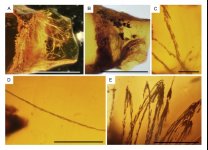Fred Ruhe
Well-known member

Pierre Cockxa, Ryan McKellara, Ralf Tappert, Matthew Vavrek, Karlis Muehlenbachs, 2020
Bonebed amber as a new source of paleontological data: The case of the Pipestone Creek deposit (Upper Cretaceous), Alberta, Canada
Gondwana Research(2020), https://doi.org/10.1016/j.gr.2019.12.005
Highlights:
Amber chemistry suggests cupressaceous trees in Late Cretaceous high latitude.
Stable isotope analyses suggest habitat distant from the Western Interior Seaway.
Relatively diverse arthropod, botanical, and vertebrate inclusions are present.
Abstract: https://www.sciencedirect.com/science/article/abs/pii/S1342937X20300198?via=ihub
Amber deposits and dinosaur bonebeds provide some of the most detailed sources of information on terrestrial ecosystems, but these sources have rarely been studied in tandem. The Pipestone Creek bonebed from the Campanian Wapiti Formation of Alberta, Canada, provides an opportunity to explore both data sources in the same deposit for the first time. The site has yielded an exceptional fauna dominated by abundant remains of the centrosaurine ceratopsian Pachyrhinosaurus. The initial campaigns of excavation in the 1980s led to the collateral discovery of amber, and the site became the first published source of insect-bearing amber in a dinosaur bonebed. Here we describe amber inclusions in detail and analyze the composition and geochemistry of the amber (FTIR spectroscopy and stable isotope studies) in order to draw paleoecological and paleoenvironmental inferences. We describe a feather fragment from an aquatic bird, as well as new species of Psocodea and Hymenoptera (Mymarommatidae) with ecological constraints. Indeterminate aphid and spider inclusions were also found, but preservation was not sufficient for formal description. FTIR spectroscopy suggests a botanical source among the Cupressaceae, while stable isotope data indicate that the resin-producing forest did not receive precipitation directly from the Western Interior Seaway. These initial results show that amber is a valuable source of additional information about the habitat surrounding the vertebrates found in bonebed deposits. Given the abundance and range of inclusions encountered so far, Pipestone Creek amber also appears to be a promising new source for a relatively diverse Campanian amber assemblage.
Enjoy,
Fred
Bonebed amber as a new source of paleontological data: The case of the Pipestone Creek deposit (Upper Cretaceous), Alberta, Canada
Gondwana Research(2020), https://doi.org/10.1016/j.gr.2019.12.005
Highlights:
Amber chemistry suggests cupressaceous trees in Late Cretaceous high latitude.
Stable isotope analyses suggest habitat distant from the Western Interior Seaway.
Relatively diverse arthropod, botanical, and vertebrate inclusions are present.
Abstract: https://www.sciencedirect.com/science/article/abs/pii/S1342937X20300198?via=ihub
Amber deposits and dinosaur bonebeds provide some of the most detailed sources of information on terrestrial ecosystems, but these sources have rarely been studied in tandem. The Pipestone Creek bonebed from the Campanian Wapiti Formation of Alberta, Canada, provides an opportunity to explore both data sources in the same deposit for the first time. The site has yielded an exceptional fauna dominated by abundant remains of the centrosaurine ceratopsian Pachyrhinosaurus. The initial campaigns of excavation in the 1980s led to the collateral discovery of amber, and the site became the first published source of insect-bearing amber in a dinosaur bonebed. Here we describe amber inclusions in detail and analyze the composition and geochemistry of the amber (FTIR spectroscopy and stable isotope studies) in order to draw paleoecological and paleoenvironmental inferences. We describe a feather fragment from an aquatic bird, as well as new species of Psocodea and Hymenoptera (Mymarommatidae) with ecological constraints. Indeterminate aphid and spider inclusions were also found, but preservation was not sufficient for formal description. FTIR spectroscopy suggests a botanical source among the Cupressaceae, while stable isotope data indicate that the resin-producing forest did not receive precipitation directly from the Western Interior Seaway. These initial results show that amber is a valuable source of additional information about the habitat surrounding the vertebrates found in bonebed deposits. Given the abundance and range of inclusions encountered so far, Pipestone Creek amber also appears to be a promising new source for a relatively diverse Campanian amber assemblage.
Enjoy,
Fred
Last edited:




